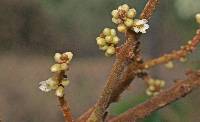

|
|
|
|
Family: Connaraceae
|
Descripción: Plantas trepadoras o lianas con tronco cilíndrico. A veces con una savia roja y aromática. Hojas trifolioladas y alternas. Folíolos de 9-25 x 4-10 cm, obovados o elípticos, con ápice agudo, bordes enteros y base redondeada o ligeramente peltada. Los folíolos son glabros o ligeramente tomentosos, a veces presentan cicatrices en el haz ocasionadas por una especie de insecto arador. Pecíolo de 5-14 cm de largo y con un pulvínulo cilíndrico en la base. Peciólulos pulvinados. Inflorescencias en panículas terminales y cubiertas de pelos ferruginosas. Flores blancas y aromáticas. Frutos en folículos obovados y compresos lateralmente, de 1.5-2.5 cm de largo, verdes, tornándose rojos o anaranjados y dehiscentes al madurar. Semillas negras, cubiertas parcialmente de un arilo amarillo. Especies Parecidas: A menudo se confunde con LK conntu Connarus turczaninowii LK2 , pero en C. turczaninowii las hojas presentan más de tres folíolos. También se puede confundir con LK protpa Protium panamense LK2 , pero P. panamense es un árbol que tiene raíces fúlcreas en la base. Usos: Las semillas se utilizan como carnada para pescar. Griseb., Bonplandia 6:6. 1858 Liana or climbing shrub, erect when juvenile, growing into lower part of canopy; trunk less than 2 cm dbh, with soft, thin, flaking bark; sap red with faint sweet aroma. Leaves weakly pubescent to glabrate; petioles 5-14 cm long, swollen and wrinkled at base; petiolules enlarged, wrinkled; leaflets 3 (5), elliptic, acuminate at apex, rounded at base with petiolule often attached slightly above base, 10-25 cm long, 3-10 cm wide (juveniles to 35 cm long and 18 cm wide). Inflorescences spicate-paniculate, terminal, densely ferruginous-tomentulose, the pubescence eventually deciduous, the axis simple or branched; flowers sessile or subsessile, sweetly aromatic; sepals 5, ovate, 1.5-2.3 mm long, often about as broad as long; petals 5, white, to 3 mm long, often with red glandular dots; stamens 10, in 2 whorls, the inner whorl much shorter, the longer filaments to 2.3 mm long, often with stipitate glands near apex; carpel 1; ovary erect-pubescent; style 1, short, conic, off-center in fruit. Follicles compressed-obovoid, 1.5-2.5 cm long, red-orange, the stalk off-center, ca 5 mm long, the valves nearly glabrous at maturity (any remaining pubescence, usually on stipe, dense and erect), dehiscing along one side to expose a single seed; seed shiny, black, arillate, ca 1.5 cm long, the aril thin, yellow, to about midway on seed, its margins +/- fimbriate. Croat 7986, 11100. Abundant along the shore; less common in the canopy of the forest, especially the young forest. Seasonal behavior uncertain. Some flowers and fruits have been seen throughout much of the year, but individuals flower at least twice a year, mostly at the beginning of the dry season, with their fruits developing within 3 months. Another and possibly even larger surge of flowering occurs during the early rainy season (July to September), but with other plants flowering even later in the rainy season. The latter part of the dry season and the earliest part of the rainy season (April to June) appear to show the least flowering activity. |
|
|
|

























